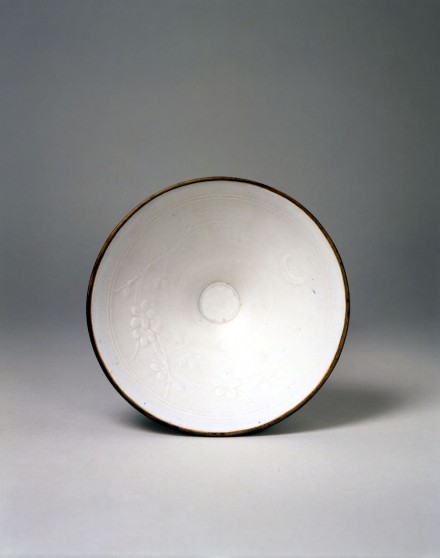J.J. Lally & Co., Oriental Art / New York City, New York
MenuPast Exhibition
Chinese Ceramics A.D. 400–1400:
Selections from an American Collection
March 19 - 31, 2007

10.
A JIANGXI SLIP-DECORATED WHITE CONICAL TEABOWL
Southern Song/Yuan Dynasty, A.D.13th Century
with flat flaring sides decorated on the interior with a finely detailed moulded design of a blossoming prunus spray and a crescent moon below a double line border under the lip, covered with an opaque white slip under a translucent pale bluish glaze, the small shallow ring foot also glazed, the pale body exposed at the unglazed rim and burnt reddish-brown in the firing, the rim bound with a copper band.
Diameter 5 5⁄8 inches (14.2 cm)
From the Collection of Robert M. Ferris IV, Windsor, Vermont
From the Collection of Mr. and Mrs. Eugene Bernat, Milton, Mass.
Exhibited
Museum of Fine Arts, Boston, 1947, Loan Exhibition, no. 67
Currier Gallery of Art, Manchester, New Hampshire, 1959, Chinese Ceramics of the Sung Dynasty, no. 25
Asia House Gallery, New York, 1962, The Art of Southern Sung China, p. 84, no. 46
Worcester Art Museum, Worcester, Mass., on extended loan
Published
by Medley, Yuan Porcelain and Stoneware, London, 1974, pl. 119A
by Wirgin, “Some Ceramic Wares from Chi-Chou,” B.M.F.E.A., Stockholm, No. 34, 1962, pl. 20 a&b
by Garner and Medley, Chinese Art, Vol. III, London, 1969, p. 219, reel 30, no. 7
by Bickford, Bones of Jade, Soul of Ice: The Flowering Plum in Chinese Art, New Haven, 1985, p. 205, fig. 91, cat. no. 63
A smaller bowl with the prunus and moon design cut through a pale qingbai glaze and dressed in brown is illustrated by Krahl, Chinese Ceramics from the Meiyintang Collection, Vol. One, London, 1994, no. 515, p. 278, where it is noted that similar wares, also with a light blue qingbai glaze applied over a slip, have been excavated at the Baishe kilns in Nanfeng county, Jiangxi province. A similar small qingbai-glazed conical bowl with cut design of a new moon and prunus branch, which was excavated at Baishe, is illustrated in Kaogu, 1985, No. 3, pl. 6: 1 & 2, and in a line drawing in fig. 4:1, p. 226. Compare also a related Southern Song celadon conical bowl decorated with the same motif of a crescent moon and a branch of flowering prunus lightly incised into the glaze, in the Rijksmuseum, Amsterdam, illustrated by Gompertz, Chinese Celadon Wares, London, 1980, pl. 93A, p. 178.
During the Song dynasty, the transitory beauty of the flowering plum or prunus blossom (mei hua) was a theme which inspired many Chinese poets and painters, and it became a very popular motif for all kinds of artisans. The delicate beauty and quiet elegance of the mei hua made it an ideal subject throughout Chinese history, but the symbolic meaning it acquired during the Song gave it a special relevance and widespread popularity in the Southern Song period. In Bones of Jade, Soul of Ice: The Flowering Plum in Chinese Art, Bickford investigates and illuminates all the various manifestations of this theme and explains its particular importance in the Southern Song period. In a section of her chapter on literary and cultural traditions, under the heading “The Flowering Plum in Southern Song” (pp. 26-28), Bickford demonstrates that the great popularity of the mei hua theme in the Song dynasty coincides with the retreat of the Song court to the south, and points out that by “…choosing Hangzhou as their capital for strategic reasons, the Song court happened to settle in the heartland of the flowering plum tradition.” The author goes on to say that Southern Song poets found in the plum blossoms of the West Lake region, and in the flowering plum’s literary tradition, appropriate emblems for their lives and sensibilities. The upheaval of the Northern-Southern Song transition and the political vulnerability of the Southern Song gave added resonance to the theme of transience embodied in the falling plum blossoms. The flowering-plum aesthetic of plain elegance suited the ultrarefined tastes of the Song elite, while the established conventions of the flowering-plum recluse reached new heights of popularity…”
10.
A JIANGXI SLIP-DECORATED WHITE CONICAL TEABOWL
Southern Song/Yuan Dynasty, A.D.13th Century
Diameter 5 5⁄8 inches (14.2 cm)